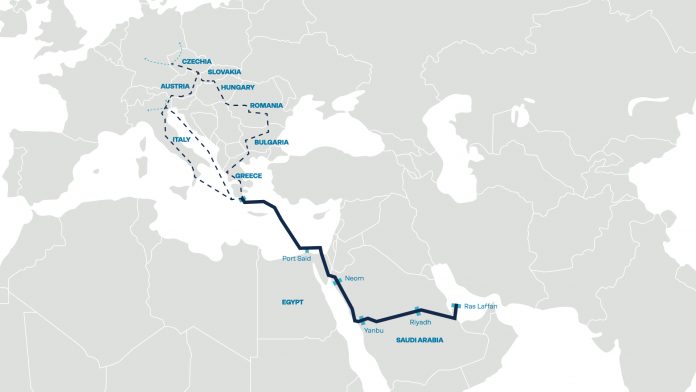RINA, inspection, certification and consulting engineering multinational, and AFRY, European engineering, design, and advisory services, have undertaken an initial study of how the Gulf region and Europe could be linked directly with a pipeline to transport low-carbon hydrogen, a key component in many climate-friendly energy and industry systems of the future. The results indicate an opportunity to fully unlock the Gulf’s potential as a cost-effective source of low-carbon hydrogen for Europe.
With abundant Renewable Energy Sources (RES) and Natural Gas reserves, the Gulf region is set to become a leading global producer of green and blue hydrogen, ammonia and other synthesis products.
The concept of a hydrogen pipeline connecting Qatar, Saudi Arabia, Egypt, and traversing the Mediterranean Sea to Europe may seem ambitious, but initial assessment indicates tat it’s feasible. The analysis shows that a suitable pipeline configuration could transport 100TWh or approximately 2.5 million tonnes of hydrogen annually. Moreover, by constructing additional pipelines of the same nature, the transport capacity could be significantly increased.
The cost of transporting hydrogen through this pipeline is initially seen at approximately €1.2/kg H2. The Gulf countries, in turn, could supply green and blue hydrogen to the economic hub of Europe at Levelised Costs Of Delivered Hydrogen (LCODH) of around €2.7/kg starting from the 2030s, decreasing to around €2.3/kg in the longer term.
Recent geopolitical challenges have forced Europe to explore alternative avenues for energy security, including linking the Eastern Mediterranean and Europe by pipeline, which was investigated for the EastMed Natural Gas project. At the same time, the discussion around exporting hydrogen and its synthesis products from the Gulf to Europe is currently revolving around molecule transport by ship. These options receive EU subsidies and drive activity within the gas/hydrogen industry, but the study claims, they may not be most efficient for bulk transport.
Andrea Bombardi, Executive Vice President at RINA said, “This study considers routing alternatives, technical parameters and feasibility, especially for the deep-sea pipeline section, geo-strategic framework conditions and top-level economic estimates of a direct hydrogen pipeline link between the Gulf and Europe as an element of an integrated green energy and industry system across Europe and MENA. Together with AFRY, we have identified a potential stable corridor to bring supply and demand together. The scale-up of hydrogen adoption goes through projects like this.”




